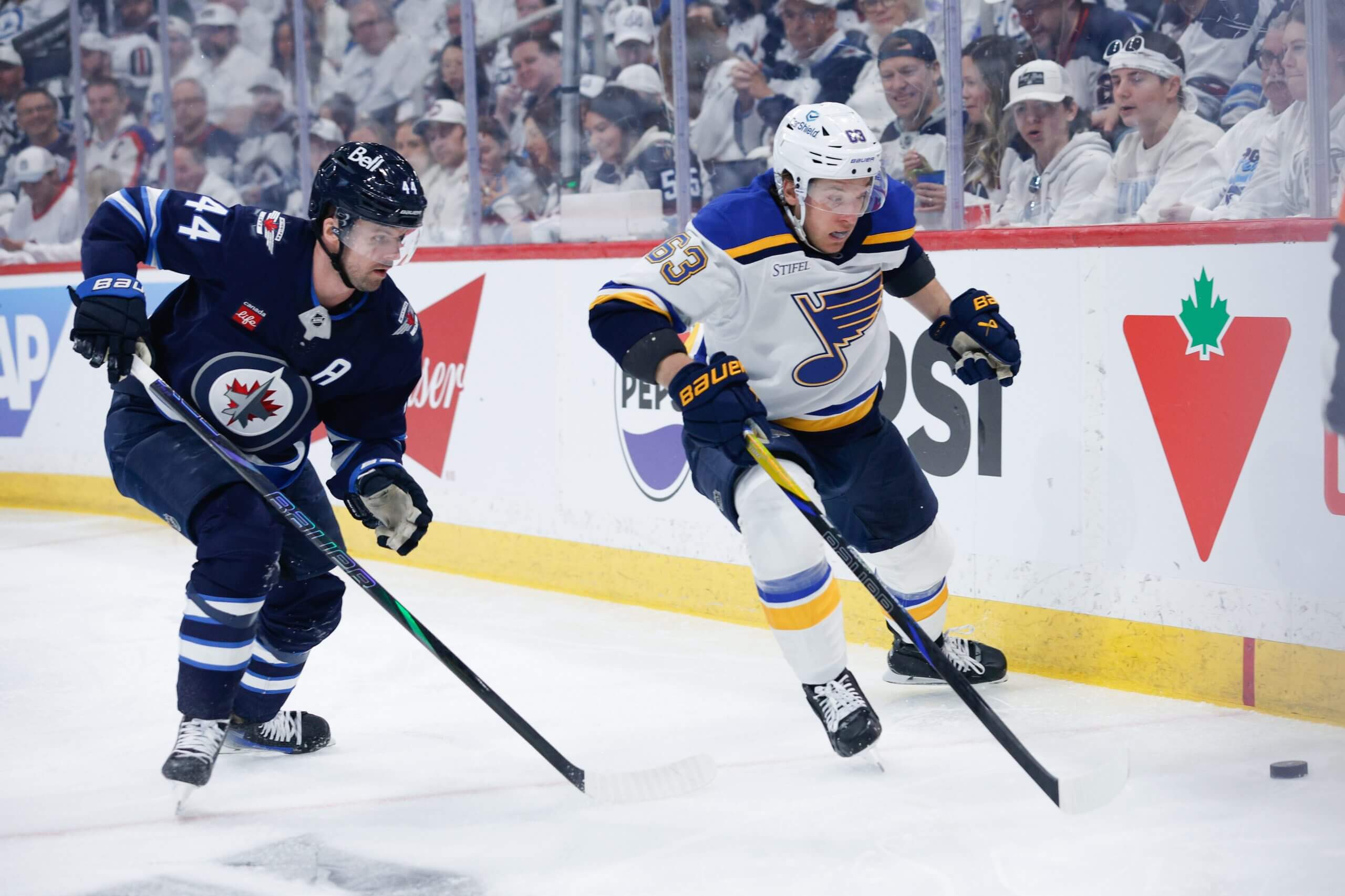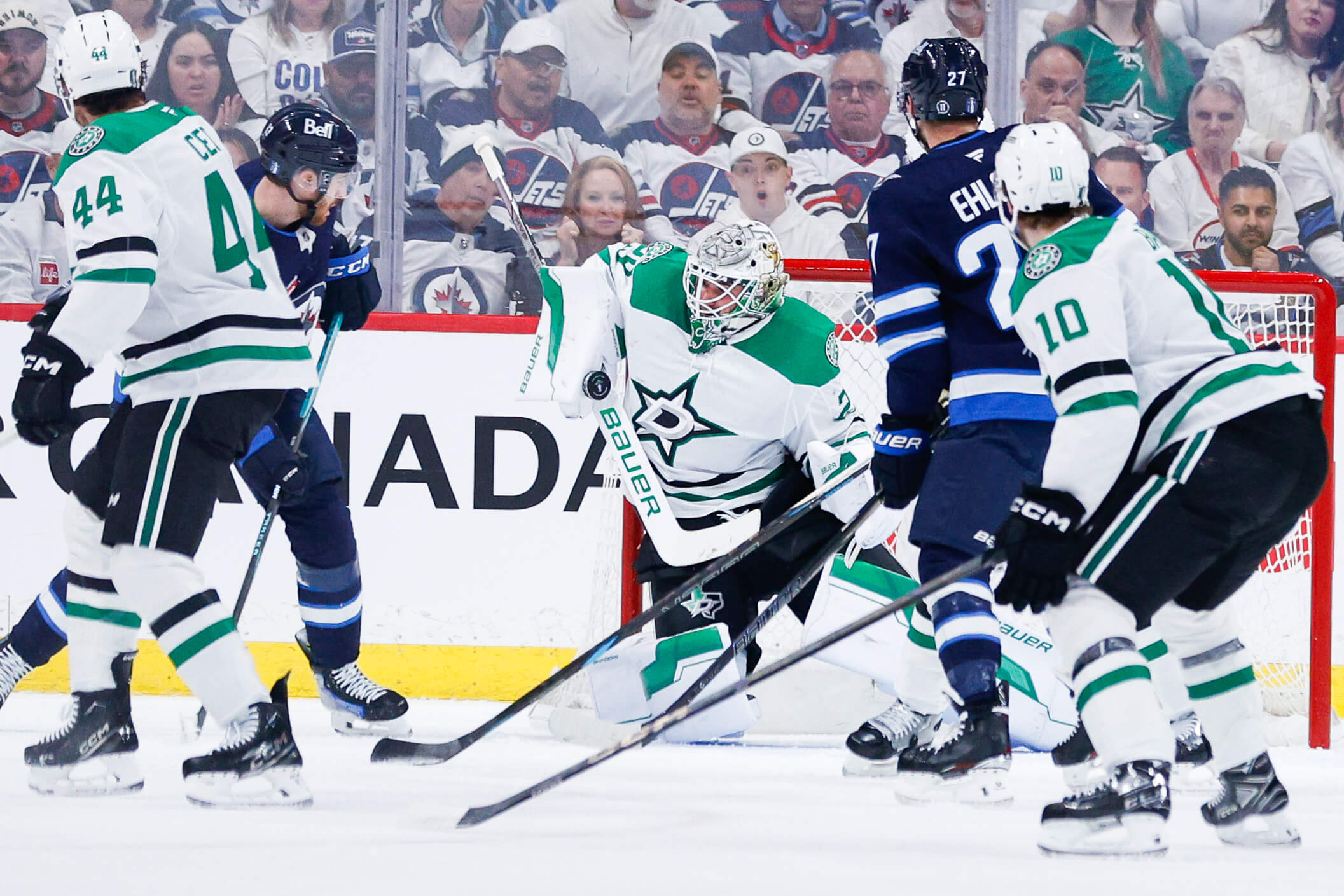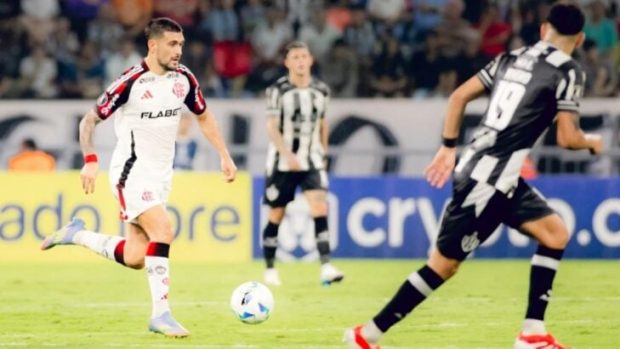
WINNIPEG — The higher the level of hockey, the more connected each play is to the one that comes before it and the one that comes next.
A goal can be the product of a zone entry that is the product of a line change that is the product of a breakout. That breakout can, in turn, be the result of a dogged backcheck made possible by the right shape of forecheck and responsible spacing in the offensive zone. It’s hockey’s butterfly effect, played at the highest speeds and greatest intensity during the Stanley Cup playoffs.
Advertisement
Game 1 between Dallas and Winnipeg showed what happens when one link in the chain gets broken. Mikko Rantanen torched the Jets for three second-period goals and needed less than a second of possession time to score them.
How did that happen?
Adam Lowry put it perfectly on Thursday, saying the Jets got burned on “the plays before the play.” When asked to expand by The Athletic, Lowry delivered analysis that was part Game 1 post-mortem and part Game 2 call-to-arms.
“I’ll just break down the first one. In the neutral zone, Sam Steel gets the puck and goes down. Rather than us getting in to him, we’re passive. We duplicate (coverage) and he has the weak side. But generally, in our coverage and the way we want to play that, we’d play it differently. We’d be more assertive.”
When Lowry talks about duplicating coverage and a passive approach, he’s taking responsibility. Watch as he crosses himself up while skating backwards to cover Steel’s zone entry, then commits to Steel outside the dots even though Neal Pionk is already there.
Who other than Mikko Rantanen? 💫
Stars tie the game halfway through the second period. pic.twitter.com/26wJ5AqNrX
— Sportsnet (@Sportsnet) May 8, 2025
“They’re on a line change, it’s a one-on-four and they maintain possession. They’re able to hit a seam pass and (Rantanen) is able to win the net-front battle,” Lowry said. “It’s little things like that. If I do a better job of getting into Steel, it doesn’t force (Pionk) to have to step up, there is no duplication there and we have layers — the proper safety valves — and that seam pass doesn’t happen.”
Watch it again with Lowry’s words in mind. It’s hockey’s butterfly effect in action: a rebound goal scored … because of a seam pass … because of duplicated coverage … because Lowry didn’t handle Steel’s zone entry attempt in the manner he’d prefer. Those kinds of details gain importance in the second period, when players have to cover more ground to get to the bench for a line change. The Jets have given up the most goals in the second period these playoffs after giving up the fewest during the regular season; it may be that they’re getting out-changed and beaten in transition.
Advertisement
“In a tight, evenly-matched series, those things are the difference,” said Lowry.
The Jets aren’t calling Friday’s rematch a “must-win,” but they’re in a hole early in Round 2. That’s why Scott Arniel seemed uniquely peeved about Winnipeg’s Game 1 loss, promising a detailed video session to prepare for Game 2. The Jets felt their wounds were self-inflicted — unacceptable, by Arniel’s standards, in the second round of the playoffs — and held extensive video sessions on Thursday to address those wounds.
What they found was a case of a Jets team losing its connective tissue. Despite playing with a full complement of forwards for the first time this postseason, Winnipeg got off to a disconnected start with players missing passes, forcing each other offside and in a couple of cases colliding with teammates.
“You know what? It wasn’t just our start,” Arniel said. “Our execution, our details, whether that’s off faceoffs, whether that’s our rush coverage, our attack, our entries, there’s just, there’s a lot of things … We looked at them this morning.”
Those aspects of the game are all connected, even if the Jets weren’t for large chunks of Game 1.
Arniel said the biggest thing he found in his video review was that his players weren’t making the most of the time and space Dallas gave them to make plays. Whereas the Blues preferred to forecheck aggressively in an effort to pound Winnipeg’s defencemen into submission, the Stars retreated into a more organized defensive structure that kept Winnipeg away from the middle of the ice. It was as though the Jets didn’t realize they had time to look up and make better decisions. In some cases, they dumped pucks into the Stars’ zone for easy recoveries even though Dallas players were backing off their blue line.
“They don’t allow the middle of the ice,” Lowry said. “But with that, there are times where you can hold onto the puck. You can drive the puck lower as opposed to chipping it when no one’s on you. Now they’re getting the retrievals (and) they’re beating us to pucks.”
Advertisement
If you’ve ever rented a car in a much bigger city than you’re used to, you might be able to relate to what Winnipeg is going through here. Move from Winnipeg’s 60 kilometre-per-hour Pembina Highway to a six-lane, 70 mile-per-hour freeway — where merging must be done at speed — and it might feel overwhelming at first. It takes a little while for the brain to get used to processing that much extra information at much greater speeds than it’s used to. The Jets seemed overwhelmed against the Blues’ forecheck at times but eventually caught up to that game speed, despite the frequent physical abuse. To continue the driving analogy, they’re home from vacation now and they’re used to a high volume of other drivers making fast, assertive decisions in a predictable rhythm — but now that rhythm is gone. The calm, potholed roads of the prairies no longer make sense to them.
“In the St. Louis series, when we were playing at our best, we made quick decisions,” Lowry said. “The reads were sharp and the execution was there.”
Dylan DeMelo explained some of Winnipeg’s issues against Dallas by way of contrast.
“There were times where we’d give up the puck when guys were close, just anticipating getting hit from the previous series,” DeMelo said. “Early in that first period, that was evident. We were kind of throwing pucks away where maybe we could’ve had a chance to hold onto it or maybe make a better play. So that’s just reading the game. As the game got going we got better, but like Adam said, it wasn’t consistent throughout.”
Wait a second. Are you saying that Winnipeg needs to play slower to have success?
I’m saying that the Jets need to get in the “pocket,” so to speak, reading and reacting to plays in front of them at an appropriate pace and rhythm. I think they got their timing settings wired one way against St. Louis and need to recalibrate for Dallas.
“When we’re on, we’re like clockwork,” Arniel said. “We’re working together as five-man units, we’re clean, we’re fast and we weren’t that (in Game 1).”

Josh Morrissey may return to the lineup for Game 2. (Terrence Lee / Imagn Images)
Morrissey: Game-time decision
There’s a chance Josh Morrissey makes his return in time for Game 2. Pionk was the only Jets player to get hit more times in Round 1 than Morrissey did, but Pionk played 33 extra minutes by virtue of Morrissey’s Game 7 injury and the double overtime that followed it.
Morrissey and Logan Stanley joined an optional skate on Thursday, each wearing regular jerseys. The skate was mostly attended by black aces and seldom-used NHL roster players, ranging from Brayden Yager to Ville Heinola. Luke Schenn also took part. It did not consist of full contact drills for any players, so we’ll have to wait until Friday’s morning skate for more clarity.
Advertisement
Arniel was asked if he’s hopeful that Morrissey plays in Game 2.
“He had a really good skate today. Both he and Stan had a real good skate today,” Arniel said.
Officially, Morrissey is a game-time decision, the same terminology Arniel has used for all of Winnipeg’s injured players. It seems as though Morrissey and Stanley are each nearing a return, although nothing is set in stone. And in Stanley’s case, Haydn Fleury may have played too well to give up his roster spot. Colin Miller has mostly played well, although he was beaten for Rantanen’s deflection goal — while being almost all over Rantanen at the time.
There was one moment when the Jets almost gave up a free rush up the middle when it seemed like the all-right-handed pair of Schenn and Miller each thought the other defenceman was going to cover the centre lane.
Weighing change on the defence pairings
No player in the playoffs has been on the ice for more five-on-five goals against than Schenn (12), although the Jets hold a 46-42 edge in shots in those minutes. I don’t expect Schenn to come out of the lineup.
One of the factors leading into Winnipeg’s decision-making in Game 1 could be that two of its three pairs were relatively new. Neither the Fleury/DeMelo nor the Miller/Schenn pairings played even 20 minutes together during the regular season. DeMelo conceded some amount of challenge moving from one partner to another, but didn’t want to overstate the impact.
“I think for me, whoever I’m playing with, I really just try to take care of what I can take care of, control what I can control and make sure that I’m the best partner for whoever I’m playing with,” he said. “If Josh is back then obviously that’s going to be a huge boost for us. We’ve obviously missed him and we know what he brings to our team.”

The Stars killed all four of the Jets’ power plays in Game 1. (Terrence Lee / Imagn Images)
Finding space on the power play
Winnipeg went 0-for-4 on the power play in Game 1, but seemed to lose momentum as the game went along.
The Jets got four shots on their first power play, including multiple chances by taking advantage of open ice down low. The Stars pressured the points and flanks but Kyle Connor and then Nikolaj Ehlers were left alone for net drives from the goal line. Mark Scheifele shot through traffic and then Gabriel Vilardi was left all alone on the goal line. It seemed as though a Vilardi-induced goal was inevitable, but the Jets’ later power plays faltered.
Advertisement
Ehlers made up for two first-period power-play giveaways with speedy puck retrievals, winning races to the boards, but hurt the power play’s momentum with more puck management issues in the second period. Entries weren’t an issue at any point; Connor, Scheifele and Vilardi combined for those. The Jets started their third power play with the second unit, which struggled to get the puck to the middle but was also given options beside the net.
The Stars seem willing to give up that first pass to the player beside the post but keep a third skater low enough in the slot to take away the slingshot pass option. As a result, I’m not sure if the Jets completed a seam pass on the power play all night.
In theory, this means the Jets should be feeding Vilardi to Jake Oettinger’s right and Ehlers to Oettinger’s left and letting them drive the net until Dallas is forced to play them tighter. (At one point, the Stars even let Connor walk straight to the net from the circle.) It’s hard to imagine too many Vilardi post-up moves going by before Winnipeg gets a goal, although the Stars did manage to close off on a pair of his most dangerous-looking moves.
Both units succeeded with their entries but Dallas pressures quickly, making it difficult to turn a successful entry into free time and space.
A matter of perspective
“They probably didn’t like it while they were watching it,” Arniel said, smiling, about Winnipeg’s lengthy video sessions. “But there’s meaning behind it: We talked about it, they recognize it. We gave up home-ice advantage last night. I’m not going to be disrespectful of Dallas, but we had a lot to do with that.”
The Jets have a certain type of swagger about them — they believe that their problems were theirs alone. But they’re not the only team in this series trying to turn Game 1 lessons into Game 2 victory. It’s hard to believe they’ve seen the Stars’ best work, either.
And there is also the matter of Winnipeg’s poor start with the puck.
“It was a hot potato at times. In the third period, we got better at it, but we needed to do it at the start,” Arniel said. “We need to have that confidence that we’re going to go out and make plays and make Dallas defend us.”
(Top photo of Mark Scheifele and Sam Steel: Terrence Lee / Imagn Images)
This news was originally published on this post .










Be the first to leave a comment